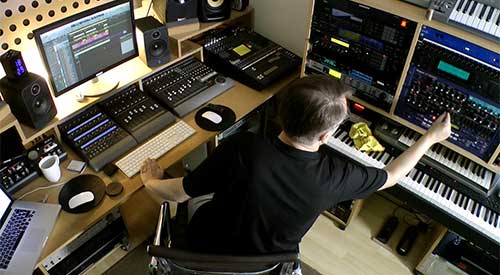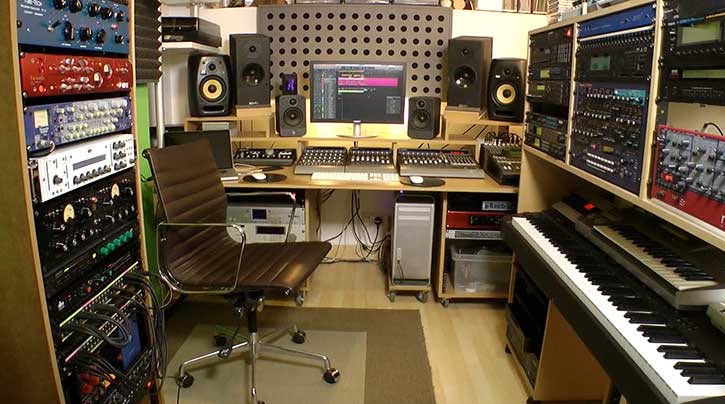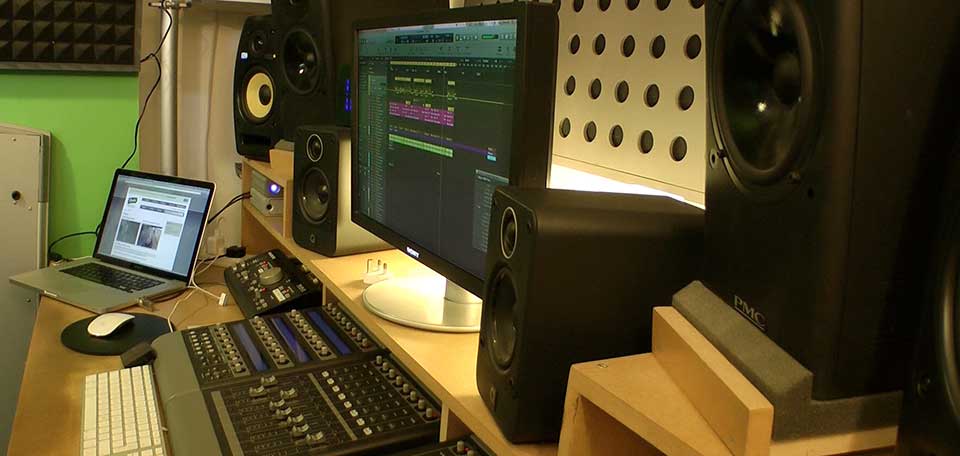Therefore, we'll base our recommendations on the equipment required for typical "project" studio. We've specified equipment that is capable of producing professional standard result (in the right hands, of course). We'll specify minimum equipment requirements and some extras which are useful if you can afford them.
By the way, you may also wish to look at our sister site www.projectstudiohandbook.com, which contains videos on technical issues for home and project studio owners.

The room
Before we get onto the equipment you will need to consider your recording environment.
Control and live?
Here are a few questions you need to ask yourself ...
- Will you need a separate live recording area (perhaps just a small booth) or will you do your mic recording in the same room as the equipment, using headphones to monitor on?
- Is the room you intend use on a busy road?, in which case double glazing will be necessary.
- Do you have neighbours above and/or below? Sound isolation between floors is usually poorer than between buildings.
- Can you connect the electricity supply for the room onto its own independent mains ring away from noise inducing devices with thermostats, such as fridges and boilers?
- Can your arrange your monitors so that they are firing down the length rather than narrow width of your room? You'll have less problem with standing waves if you can.
Room acoustics
Acoustic treatments and sound proofing is covered here.
Furniture
- Have you considered the importance of a good supportive and comfortable chair or two and furniture that will allow you to arrange your equipment for best sound quality and ease of use?
- Can your monitors be positioned 1.5 to 2m apart in the near field with the tweeters at ear height?
- Can the top of your computer screen be at eye level?

Monitoring
Monitors/loudspeakers
Professional monitors are desirable in professional studios for their wide and flat frequency response, wide dynamic range and durability. Project studios can get away with a good quality amp and pair of hi-fi speakers. Not too cheap and not too expensive will do. Just remember you will need to listen to a lot of music (CDs, MP3s etc) on them to get to know them and you will need to test your mixes on as many alternative systems (iPods, car stereos, radios, friends systems, club PA's) as possible.
Headphones
You will need a good pair of closed back headphones for singers and musicians to wear when recording vocals and acoustic instruments. Closed back headphones don't allow any sound to leak out. Even good headphones are not a suitable substitute for monitor speakers for mixing although they are useful for checking panning, reverberation and the mobile (iPod) experience. We don't recommend Beyer DT100'a which are built for durability and not sound quality.
You will also need to check your mixes on mobile/phone ear buds, now that so many people listen to music that way.

DAW (digital audio workstation)
Although not the only option, a DAW (Digital Audio Workstation) is the choice for most recording setups, offering unparalleled flexibility. We need to specify a computer system for DAW software carefully to ensure all the hardware and software integrates without any issues.
If you're buying a Mac (a Mac Mini with a copy of Logic Pro X is a great place to start), you have very little to worry about. There are many all-in-one systems (such as Apple's laptops, iMacs and Mac Mini), and pretty much all recent models are powerful enough to run Cubase, Logic Pro X or ProTools.
But if you want to use a PC or configure a MacPro you need to consider several factors. Here's some advice ..
| Component | Minimum specification |
|---|---|
| Power supply & fan | The quietest models you can afford. You need to keep the noise down |
| Internal hard drive | 7,200 rpm. 500Gb+. eSata or IDE connection |
| External backup drive | 7,200 rpm. 500Gb+. USB 2/3, Thuderbolt are fine. eSATA is faster but not essential. Firewire is on the way out so no longer essential. |
| DVD-R / CD-R backup drive | Useful for backing up song sessions |
| CPU | Fastest most powerful you can afford |
| RAM | 8Gb minimum |
| Connectivity | USB 2/3, HDMI or DVI, Thunderbolt, PCI-e (if you plan to add expansion cards in the future). Firewire is on the way out so no longer essential. |
| Graphics card | Anything that can support at least a 24" monitor |
| Monitor | 20" minimum, but 23-4" is better (obviously!). Laptop monitor resolutions are fine. |
| OS | Mac OSX or Windows. Check Windows driver compatibility first with any audio interface and controller keyboard you plan to buy. The Mac OSX should work with anything, however the latest version (Mavericks) is still not fully supported by all manufactures but it will be soon. |
| Mouse | A really good ergonomic and comfortable optical mouse to suit you |
| Cable modem or similar broadband connection | 4Mbps preferably 8-10Mbps |
| Disk repair / de fragmentation application | No longer necessary for Mac OSX (which does this itself), but may be useful for Windows. |
| Red book audio CD creation application | Totally optional now that many independent artists just sell digital downloads, but you can check out Roxio Jam, Steinberg Wavelab,and Sony CD Architect/Sound Forge. |
| DVD / CD data burning application. | Generally these are built into OS's, but although not essential, you could look at the advanced options of Nero, Easy CD creator, and Toast. |
| Audio sequencer application | Logic Pro, Cubase, Sonar, Performer, Alberton Live are all good options. |
| Additional instrument and effect plug-ins | Optional and up to you. If you have Cubase or Logic Pro you can get along fine with the included plug-ins |
| Audio interface | USB 2/3 or Thuderbolt (we don't recommend FireWire which is on the way out) connection to the computer, and needs to include ... Compatible driver for your OS, XLR mic in with phantom power (preferably 2 for stereo recording) and gain control, 2 x 1/4" jack line ins, Instrument (guitar) in, direct stereo (low latency) monitor out on 1/4" jacks or phono's with volume control, Headphone output with separate volume control, S/PDIF or Toslink digital in/out, MIDI in/out |
| Controller keyboard | 4-5 octave with MIDI or USB connection |
Instruments
We have no recommendations here, except to say that recording "real" instruments will significantly enhance your recordings, bringing frequencies and timbres that can make your mixes sound, well ... more 3D! We love guitars and percussion. Even shakers and tambourines can bring a track to life.
Interconnection
Don't underestimate the cost of all the cabling you will need. Buying a soldering iron and components and learning how to create audio cables is a useful and cost effective skill. You will be able to make cables of equivalent quality to ones available in the shops but at a quarter of the cost.
Checkout our video on making leads.
You should also consider buying an 8 or 6 way fused and surge protected distribution board for your power needs. If necessary connect multiple boards in a "family tree" arrangement. Don't daisy chain them. You can look your equipment manuals for the wattage requirements. If you add them all together you should find that the total power requirements are less than a fridge or similar appliance.
If at all possible connect your studio gear to a separate mains ring from appliances with thermostats such as fridges, washing machines, boilers and heaters.
Cables you will need ...
- Mains (kettle)
- USB and/or FireWire
- 1/4" jack unbalanced (for guitars)
- 1/4" jack balanced for audio interface line inputs
- Phono to jack leads and/or adaptors
- XLR (canon) mic
- Headphone extension
- Monitor extension cable (in case you need to site your computer away from your monitoring position because of noise)
- Good quality speaker cable (but none of that esoteric hi-fi nonsense)
Typical project studio processes - required equipment
Here are our recommendations ..
| Process | Minimum equipment required | Recommended |
|---|---|---|
| Program / sequence drum parts | DAW, plug-in instruments, effects, and 'soft' sampler with library (all usually included with DAW software) | Some kind of drum pads like the Alesis Control Pad |
| Record an electric bass guitar and an electric guitar | DAW, DI box, mic cable, jack lead | Dynamic mic (Shure SM57) and mic stand for your amp/cabinet or combo |
| Record acoustic and percussion instruments | DAW, small diaphragm condenser mic such as those made by SE Electronic or Rode, mic cable, mic stand | Stereo pair |
| Record and edit MIDI keyboard, synth and sample instruments | DAW | Control surface |
| Record vocals | DAW, closed back headphones, large condenser microphone (too many models to mention), suspension mount, pop shield, boom mic stand | Compressor on mic input (voice channel), music stand, SE Refexion filter |
| Mix with effects and dynamic processors | DAW | |
| Create a Red Book audio CD | DAW, Red Book mastering software with mastering plug-ins (multi-band compressor, mastering EQ etc) | |
| Create CD artwork | Photoshop and/or CMYK capable DTP program | Digital camera (4megapixels+) with a good (big) lens |
| Produce CD inlays | Photo quality ink-jet printer, scalpel, metal ruler | |
| Create MP3 files | DAW or iTunes (which has an excellent built-in conversion algorithm) |
This is just the beginning!
You do know that if you start down this path there will be no end to the upgrading and improving, don't you?! Your partner will leave you, anyone you know who isn't involved in recording or music will get the elbow, and you'll be happy as Larry when a track is going well and unbearable when it's all going badly! :-)
Oh, and you'll spend 10 times as much on your studio as you every make out of it. Or is that just me?!
To ensure you don't miss out on any of our new article and videos, don't forget to ..
- subscribe to our mailing list
- visit www.projectstudiohandbook.com
- subscribe to our Project Studio Handbook and Planet of Tunes YouTube channels
Good luck!


